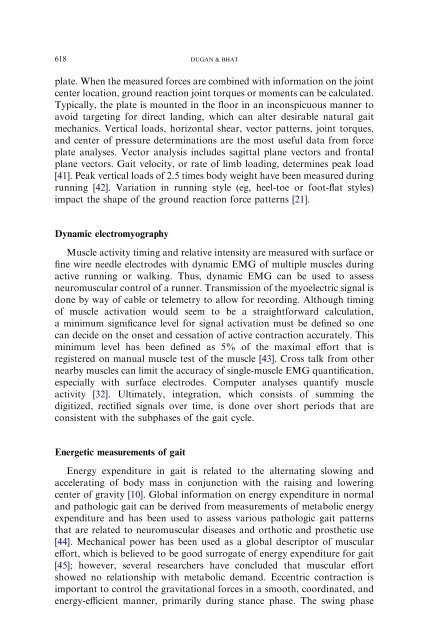Biomechanics and Analysis of Running Gait
Analysis of running
Analysis of running
You also want an ePaper? Increase the reach of your titles
YUMPU automatically turns print PDFs into web optimized ePapers that Google loves.
618 DUGAN & BHATplate. When the measured forces are combined with information on the jointcenter location, ground reaction joint torques or moments can be calculated.Typically, the plate is mounted in the floor in an inconspicuous manner toavoid targeting for direct l<strong>and</strong>ing, which can alter desirable natural gaitmechanics. Vertical loads, horizontal shear, vector patterns, joint torques,<strong>and</strong> center <strong>of</strong> pressure determinations are the most useful data from forceplate analyses. Vector analysis includes sagittal plane vectors <strong>and</strong> frontalplane vectors. <strong>Gait</strong> velocity, or rate <strong>of</strong> limb loading, determines peak load[41]. Peak vertical loads <strong>of</strong> 2.5 times body weight have been measured duringrunning [42]. Variation in running style (eg, heel-toe or foot-flat styles)impact the shape <strong>of</strong> the ground reaction force patterns [21].Dynamic electromyographyMuscle activity timing <strong>and</strong> relative intensity are measured with surface orfine wire needle electrodes with dynamic EMG <strong>of</strong> multiple muscles duringactive running or walking. Thus, dynamic EMG can be used to assessneuromuscular control <strong>of</strong> a runner. Transmission <strong>of</strong> the myoelectric signal isdone by way <strong>of</strong> cable or telemetry to allow for recording. Although timing<strong>of</strong> muscle activation would seem to be a straightforward calculation,a minimum significance level for signal activation must be defined so onecan decide on the onset <strong>and</strong> cessation <strong>of</strong> active contraction accurately. Thisminimum level has been defined as 5% <strong>of</strong> the maximal effort that isregistered on manual muscle test <strong>of</strong> the muscle [43]. Cross talk from othernearby muscles can limit the accuracy <strong>of</strong> single-muscle EMG quantification,especially with surface electrodes. Computer analyses quantify muscleactivity [32]. Ultimately, integration, which consists <strong>of</strong> summing thedigitized, rectified signals over time, is done over short periods that areconsistent with the subphases <strong>of</strong> the gait cycle.Energetic measurements <strong>of</strong> gaitEnergy expenditure in gait is related to the alternating slowing <strong>and</strong>accelerating <strong>of</strong> body mass in conjunction with the raising <strong>and</strong> loweringcenter <strong>of</strong> gravity [10]. Global information on energy expenditure in normal<strong>and</strong> pathologic gait can be derived from measurements <strong>of</strong> metabolic energyexpenditure <strong>and</strong> has been used to assess various pathologic gait patternsthat are related to neuromuscular diseases <strong>and</strong> orthotic <strong>and</strong> prosthetic use[44]. Mechanical power has been used as a global descriptor <strong>of</strong> musculareffort, which is believed to be good surrogate <strong>of</strong> energy expenditure for gait[45]; however, several researchers have concluded that muscular effortshowed no relationship with metabolic dem<strong>and</strong>. Eccentric contraction isimportant to control the gravitational forces in a smooth, coordinated, <strong>and</strong>energy-efficient manner, primarily during stance phase. The swing phase


